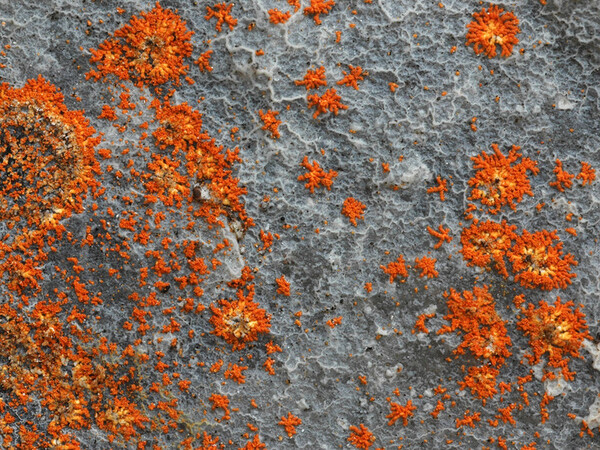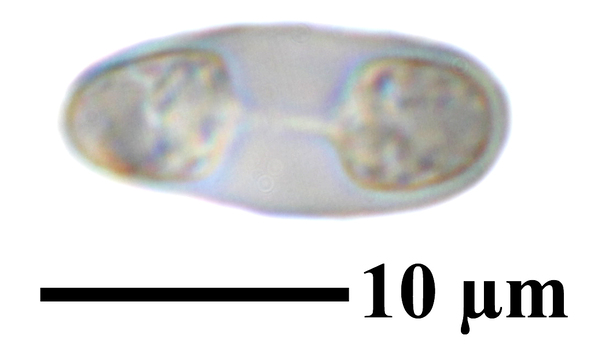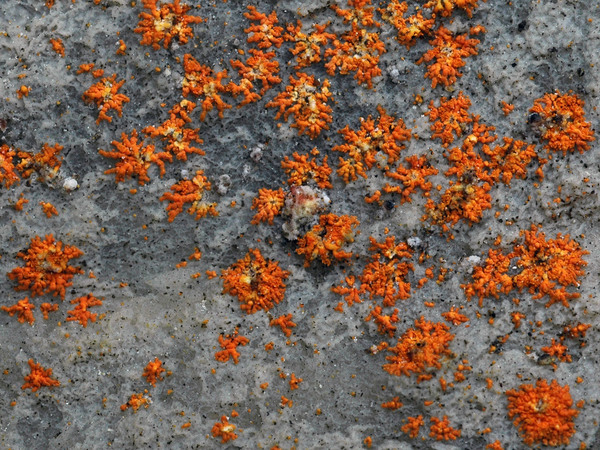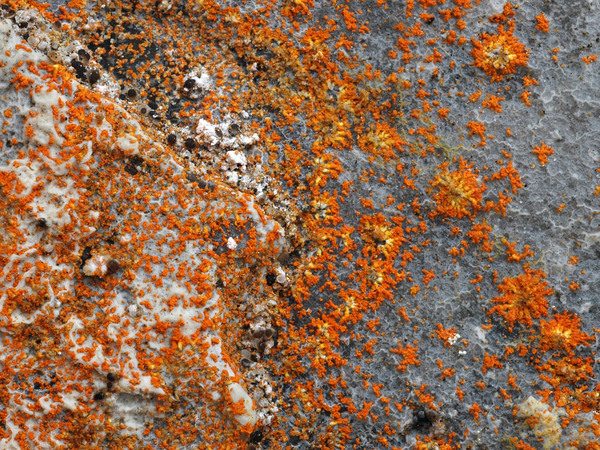Leproplaca proteus (Poelt) Arup, Frödén & Søchting
in Arup & al., Nord. J. Bot., 31: 73, 2013. Basionym: Caloplaca proteus Poelt - Mitt. bot. Staatss. München: 329, 1953.
Synonyms: Caloplaca cirrochroa subsp. fulva (Körb.) Clauzade & Cl. Roux; Placodium pusillum var. miniatum sensu Anzi
Distribution: N - Ven (Nimis 1994, Nascimbene & Caniglia 2003c, Nascimbene 2008c), TAA (Nascimbene 2008b, Nascimbene & al. 2022), Lomb, Piem (Isocrono & al. 2004), VA (vidi!), Emil (Fariselli & al. 2020). C - Sar. S - Bas (CLU 10221).
Description: Thallus crustose-placodioid, episubstratic, orange-red, closely attached, forming regular to irregular, up to 8(-10) mm wide rosettes. Lobes 0.5-1 mm long and 0.1-0.2(-0.4) mm wide, convex, usually diverging, epruinose at tips, with laminal, ulcerose, reddish orange, round, sometimes confluent soralia bearing farinose soredia. Cortex cellular, with granules insoluble in K; medulla prosoplectenchymatous. Apothecia rare, in the central parts of the rosettes, adnate, to 0.1-0.3(-0.4) mm across, orange, with a more or less persistent, sorediate-granulose, orange thalline margin. Epithecium orange, with a granular epipsamma reacting K+ purple-red; hymenium colourless; paraphyses simple to forked, 2-2.5 μm thick at base, with 1-3, swollen-globose apical cells; hypothecium colourless. Asci 8-spored, clavate, functionally unitunicate, apically thickened with a broad internal beak, the inner part of apex and external cap I+ blue, Teloschistes-type. Ascospores 2-celled, polarilocular, hyaline, ellipsoid, thin-walled, 9-13(-15) x 5-7(-8) µm, the equatorial thickening (“septum”) 2-3(-4) µm. Photobiont chlorococcoid. Spot tests: thallus, sopalia and apothecia K+ purple-red, C-, KC-, P-, UV+ orange. Chemistry: parietin (major), fallacinal, emodin, teloschistin and parietinic acid (minor), corresponding with chemosyndrome A of Søchting (1997). Note: on steeply inclined to rain-sheltered surfaces of compact, more or less calcareous rocks in rather sheltered situations, restricted to warm-dry sites in the mountains. See also note on L. cirrochroa.
Growth form: Crustose placodiomorph
Substrata: rocks
Photobiont: green algae other than Trentepohlia
Reproductive strategy: mainly asexual, by soredia, or soredia-like structures (e.g. blastidia)
Commonnes-rarity: (info)
Alpine belt: rather rare
Subalpine belt: rare
Oromediterranean belt: very rare
Montane belt: extremely rare
Submediterranean belt: absent
Padanian area: absent
Humid submediterranean belt: absent
Humid mediterranean belt: absent
Dry mediterranean belt: absent
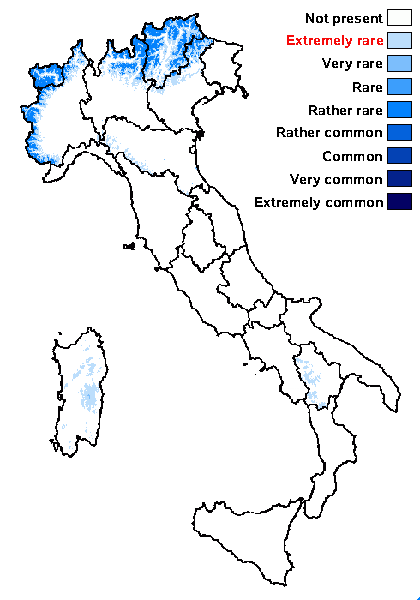
Predictive model
Herbarium samples

Felix Schumm - CC BY-SA 4.0
[BR5030038363483],Österreich, Tirol, Gschnitztal unterhalb St. Magdalena, auf senkrechter west-exponierter Wand, auf Kalk, zusammen mit Caloplaca cirrochroa, 1450 m. Leg. et det. M. Steiner, 30.07.1956, teste J. Poelt.
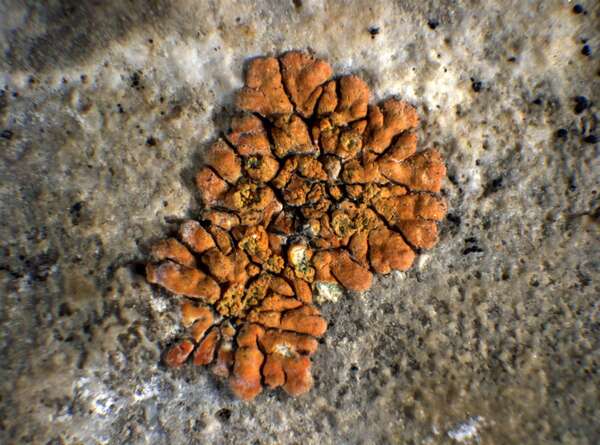

P.L. Nimis; Owner: Department of Life Sciences, University of Trieste
Herbarium: TSB (33976)
2001/11/19
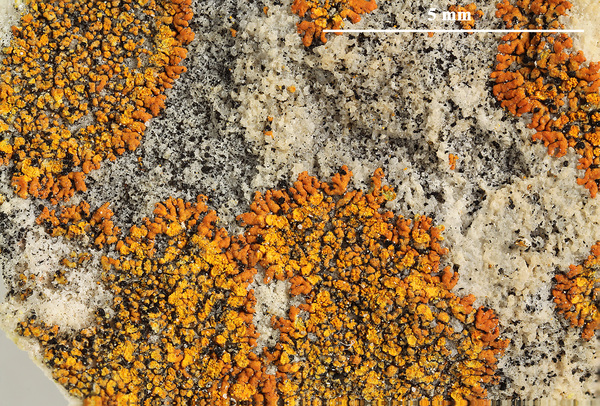
Felix Schumm - CC BY-SA 4.0
[BR5030038363483],Österreich, Tirol, Gschnitztal unterhalb St. Magdalena, auf senkrechter west-exponierter Wand, auf Kalk, zusammen mit Caloplaca cirrochroa, 1450 m. Leg. et det. M. Steiner, 30.07.1956, teste J. Poelt.
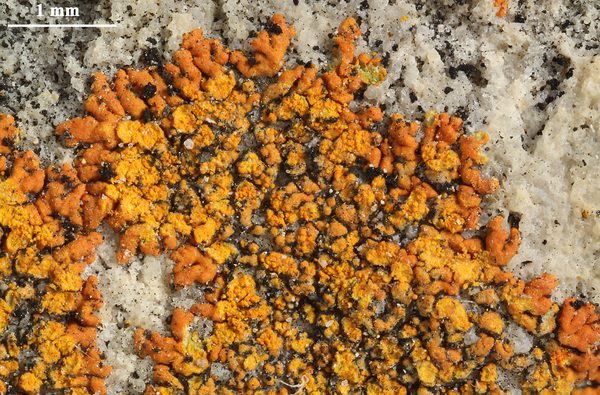
Felix Schumm - CC BY-SA 4.0
[BR5030038363483],Österreich, Tirol, Gschnitztal unterhalb St. Magdalena, auf senkrechter west-exponierter Wand, auf Kalk, zusammen mit Caloplaca cirrochroa, 1450 m. Leg. et det. M. Steiner, 30.07.1956, teste J. Poelt.
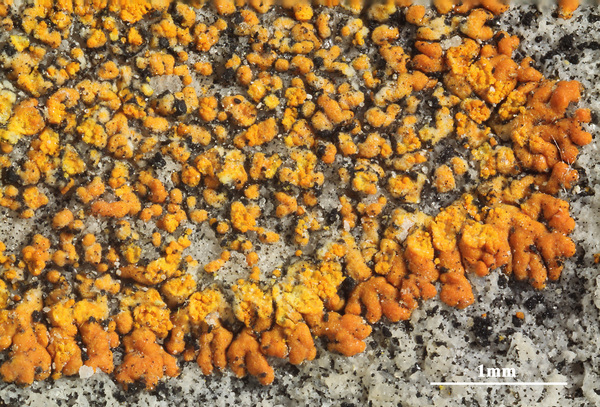
Felix Schumm - CC BY-SA 4.0
[BR5030038363483],Österreich, Tirol, Gschnitztal unterhalb St. Magdalena, auf senkrechter west-exponierter Wand, auf Kalk, zusammen mit Caloplaca cirrochroa, 1450 m. Leg. et det. M. Steiner, 30.07.1956, teste J. Poelt.
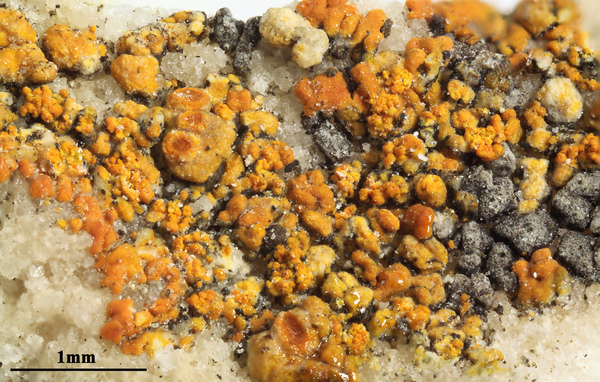
Felix Schumm - CC BY-SA 4.0
[BR5030038363483],Österreich, Tirol, Gschnitztal unterhalb St. Magdalena, auf senkrechter west-exponierter Wand, auf Kalk, zusammen mit Caloplaca cirrochroa, 1450 m. Leg. et det. M. Steiner, 30.07.1956, teste J. Poelt.
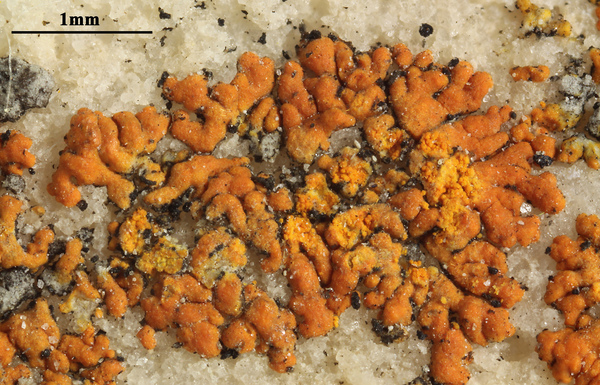
Felix Schumm - CC BY-SA 4.0
[BR5030038363483],Österreich, Tirol, Gschnitztal unterhalb St. Magdalena, auf senkrechter west-exponierter Wand, auf Kalk, zusammen mit Caloplaca cirrochroa, 1450 m. Leg. et det. M. Steiner, 30.07.1956, teste J. Poelt.
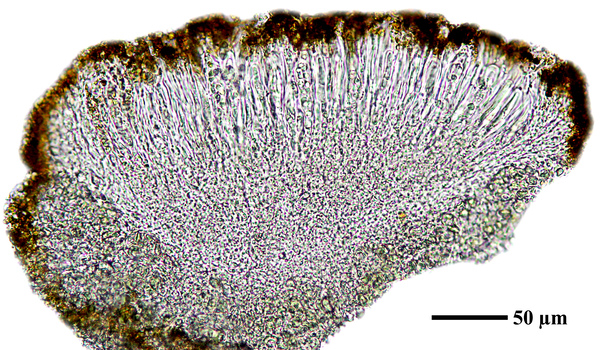
Felix Schumm - CC BY-SA 4.0
[BR5030038363483],Österreich, Tirol, Gschnitztal unterhalb St. Magdalena, auf senkrechter west-exponierter Wand, auf Kalk, zusammen mit Caloplaca cirrochroa, 1450 m. Leg. et det. M. Steiner, 30.07.1956, teste J. Poelt.
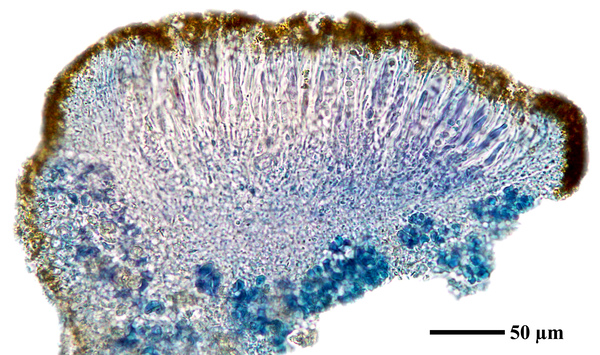
Felix Schumm - CC BY-SA 4.0
[BR5030038363483],Österreich, Tirol, Gschnitztal unterhalb St. Magdalena, auf senkrechter west-exponierter Wand, auf Kalk, zusammen mit Caloplaca cirrochroa, 1450 m. Leg. et det. M. Steiner, 30.07.1956, teste J. Poelt.
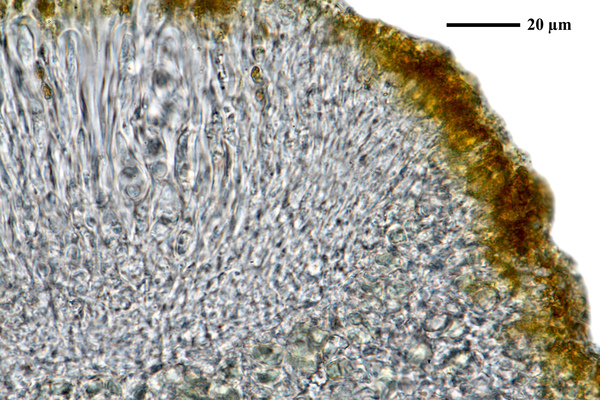
Felix Schumm - CC BY-SA 4.0
[BR5030038363483],Österreich, Tirol, Gschnitztal unterhalb St. Magdalena, auf senkrechter west-exponierter Wand, auf Kalk, zusammen mit Caloplaca cirrochroa, 1450 m. Leg. et det. M. Steiner, 30.07.1956, teste J. Poelt.

Felix Schumm - CC BY-SA 4.0
[BR5030038363483],Österreich, Tirol, Gschnitztal unterhalb St. Magdalena, auf senkrechter west-exponierter Wand, auf Kalk, zusammen mit Caloplaca cirrochroa, 1450 m. Leg. et det. M. Steiner, 30.07.1956, teste J. Poelt.

Felix Schumm - CC BY-SA 4.0
[BR5030038363483],Österreich, Tirol, Gschnitztal unterhalb St. Magdalena, auf senkrechter west-exponierter Wand, auf Kalk, zusammen mit Caloplaca cirrochroa, 1450 m. Leg. et det. M. Steiner, 30.07.1956, teste J. Poelt.
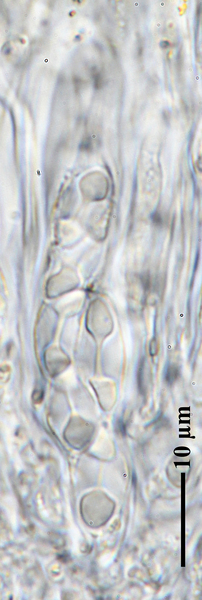
Felix Schumm - CC BY-SA 4.0
[BR5030038363483],Österreich, Tirol, Gschnitztal unterhalb St. Magdalena, auf senkrechter west-exponierter Wand, auf Kalk, zusammen mit Caloplaca cirrochroa, 1450 m. Leg. et det. M. Steiner, 30.07.1956, teste J. Poelt.
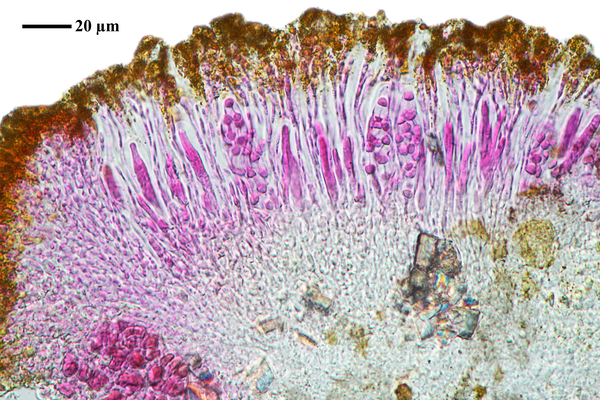
Felix Schumm - CC BY-SA 4.0
[BR5030038363483],Österreich, Tirol, Gschnitztal unterhalb St. Magdalena, auf senkrechter west-exponierter Wand, auf Kalk, zusammen mit Caloplaca cirrochroa, 1450 m. Leg. et det. M. Steiner, 30.07.1956, teste J. Poelt.
Growth form: Crustose placodiomorph
Substrata: rocks
Photobiont: green algae other than Trentepohlia
Reproductive strategy: mainly asexual, by soredia, or soredia-like structures (e.g. blastidia)
Commonnes-rarity: (info)
Alpine belt: rather rare
Subalpine belt: rare
Oromediterranean belt: very rare
Montane belt: extremely rare
Submediterranean belt: absent
Padanian area: absent
Humid submediterranean belt: absent
Humid mediterranean belt: absent
Dry mediterranean belt: absent

Predictive model
| Herbarium samples |

Felix Schumm - CC BY-SA 4.0
[BR5030038363483],Österreich, Tirol, Gschnitztal unterhalb St. Magdalena, auf senkrechter west-exponierter Wand, auf Kalk, zusammen mit Caloplaca cirrochroa, 1450 m. Leg. et det. M. Steiner, 30.07.1956, teste J. Poelt.


P.L. Nimis; Owner: Department of Life Sciences, University of Trieste
Herbarium: TSB (33976)
2001/11/19

Felix Schumm - CC BY-SA 4.0
[BR5030038363483],Österreich, Tirol, Gschnitztal unterhalb St. Magdalena, auf senkrechter west-exponierter Wand, auf Kalk, zusammen mit Caloplaca cirrochroa, 1450 m. Leg. et det. M. Steiner, 30.07.1956, teste J. Poelt.

Felix Schumm - CC BY-SA 4.0
[BR5030038363483],Österreich, Tirol, Gschnitztal unterhalb St. Magdalena, auf senkrechter west-exponierter Wand, auf Kalk, zusammen mit Caloplaca cirrochroa, 1450 m. Leg. et det. M. Steiner, 30.07.1956, teste J. Poelt.

Felix Schumm - CC BY-SA 4.0
[BR5030038363483],Österreich, Tirol, Gschnitztal unterhalb St. Magdalena, auf senkrechter west-exponierter Wand, auf Kalk, zusammen mit Caloplaca cirrochroa, 1450 m. Leg. et det. M. Steiner, 30.07.1956, teste J. Poelt.

Felix Schumm - CC BY-SA 4.0
[BR5030038363483],Österreich, Tirol, Gschnitztal unterhalb St. Magdalena, auf senkrechter west-exponierter Wand, auf Kalk, zusammen mit Caloplaca cirrochroa, 1450 m. Leg. et det. M. Steiner, 30.07.1956, teste J. Poelt.

Felix Schumm - CC BY-SA 4.0
[BR5030038363483],Österreich, Tirol, Gschnitztal unterhalb St. Magdalena, auf senkrechter west-exponierter Wand, auf Kalk, zusammen mit Caloplaca cirrochroa, 1450 m. Leg. et det. M. Steiner, 30.07.1956, teste J. Poelt.

Felix Schumm - CC BY-SA 4.0
[BR5030038363483],Österreich, Tirol, Gschnitztal unterhalb St. Magdalena, auf senkrechter west-exponierter Wand, auf Kalk, zusammen mit Caloplaca cirrochroa, 1450 m. Leg. et det. M. Steiner, 30.07.1956, teste J. Poelt.

Felix Schumm - CC BY-SA 4.0
[BR5030038363483],Österreich, Tirol, Gschnitztal unterhalb St. Magdalena, auf senkrechter west-exponierter Wand, auf Kalk, zusammen mit Caloplaca cirrochroa, 1450 m. Leg. et det. M. Steiner, 30.07.1956, teste J. Poelt.

Felix Schumm - CC BY-SA 4.0
[BR5030038363483],Österreich, Tirol, Gschnitztal unterhalb St. Magdalena, auf senkrechter west-exponierter Wand, auf Kalk, zusammen mit Caloplaca cirrochroa, 1450 m. Leg. et det. M. Steiner, 30.07.1956, teste J. Poelt.

Felix Schumm - CC BY-SA 4.0
[BR5030038363483],Österreich, Tirol, Gschnitztal unterhalb St. Magdalena, auf senkrechter west-exponierter Wand, auf Kalk, zusammen mit Caloplaca cirrochroa, 1450 m. Leg. et det. M. Steiner, 30.07.1956, teste J. Poelt.

Felix Schumm - CC BY-SA 4.0
[BR5030038363483],Österreich, Tirol, Gschnitztal unterhalb St. Magdalena, auf senkrechter west-exponierter Wand, auf Kalk, zusammen mit Caloplaca cirrochroa, 1450 m. Leg. et det. M. Steiner, 30.07.1956, teste J. Poelt.

Felix Schumm - CC BY-SA 4.0
[BR5030038363483],Österreich, Tirol, Gschnitztal unterhalb St. Magdalena, auf senkrechter west-exponierter Wand, auf Kalk, zusammen mit Caloplaca cirrochroa, 1450 m. Leg. et det. M. Steiner, 30.07.1956, teste J. Poelt.

 INDEX FUNGORUM
INDEX FUNGORUM
 GBIF
GBIF
 DOLICHENS
DOLICHENS
